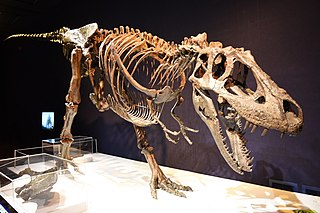
Daspletosaurus is a genus of tyrannosaurid dinosaur that lived in Laramidia between about 78 and 74.4 million years ago, during the Late Cretaceous Period. The genus Daspletosaurus contains three named species. Fossils of the earlier type species, D. torosus, have been found in Alberta, while fossils of a later species, D. horneri, have been found only in Montana. D. wilsoni has been suggested as an intermediate species between D. torosus and D. horneri that evolved through anagenesis, but this theory has been disputed by other researchers. There are also multiple specimens which may represent new species of Daspletosaurus from Alberta and Montana, but these have not been formally described. The taxon Thanatotheristes has been suggested to represent a species of Daspletosaurus, D. degrootorum, but this has not been widely supported. Daspletosaurus is closely related to the much larger and more recent tyrannosaurid Tyrannosaurus rex. Like most tyrannosaurids, Daspletosaurus was a large bipedal predator, measuring around 8.5–9 metres (28–30 ft) long and weighing up to 2–3 metric tons, equipped with dozens of large, sharp teeth. Daspletosaurus had the small forelimbs typical of tyrannosaurids, although they were proportionately longer than in other genera.
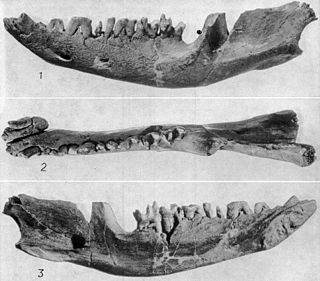
Eodelphis, from eo- plus [Di]delphis, thus meaning "very early opossum", is a genus of stagodont metatherians from the Late Cretaceous of North America, with distinctive crushing dentition. Named species include E. browni and the more advanced E. cutleri. Both come from the Late Campanian of Dinosaur Provincial Park, Alberta. Specimens are also known from the Judith River Formation of Montana. E. cutleri is related to the Maastrichtian genus Didelphodon as indicated by its enlarged premolars and more robust jaw. Eodelphis was probably an aquatic predator like its relative Didelphodon, and may have weighed about 0.6 kg (1.3 lb), making it one of the largest mammals of its time.

Zapsalis is a genus of dromaeosaurine theropod dinosaurs. It is a tooth taxon, often considered dubious because of the fragmentary nature of the fossils, which include teeth but no other remains.

Scolosaurus is an extinct genus of ankylosaurid dinosaurs within the subfamily Ankylosaurinae. It is known from the lower levels of the Dinosaur Park Formation and upper levels of the Oldman Formation in the Late Cretaceous of Alberta, Canada. It contains two species, S. cutleri and S. thronus. The type species, S. cutleri, measured up to 5.6 metres (18 ft) in length and 2.2 metric tons in body mass.
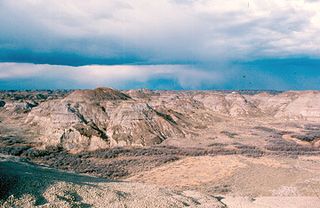
The Dinosaur Park Formation is the uppermost member of the Belly River Group, a major geologic unit in southern Alberta. It was deposited during the Campanian stage of the Late Cretaceous, between about 76.5 and 74.4 million years ago. It was deposited in alluvial and coastal plain environments, and it is bounded by the nonmarine Oldman Formation below it and the marine Bearpaw Formation above it.
The Oldman Formation is a stratigraphic unit of Late Cretaceous age that underlies much of southern Alberta, Canada. It consists primarily of sandstones that were deposited in fluvial channel and floodplain environments. It was named for exposures along the Oldman River between its confluence with the St. Mary River and the city of Lethbridge, and it is known primarily for its dinosaur remains and other fossils.
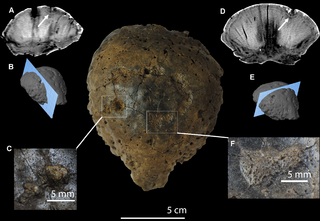
Hanssuesia is a genus of pachycephalosaurid dinosaurs from the late Cretaceous period. It lived in what is now Alberta and Montana, and contains the single species Hanssuesia sternbergi.
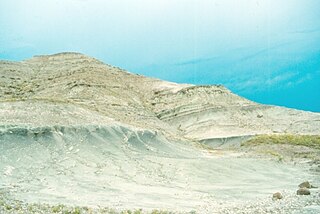
The Two Medicine Formation is a geological formation, or rock body, in northwestern Montana and southern Alberta that was deposited between 83.5 ± 0.7 Ma and 70.6 ± 3.4 Ma, during Campanian time. It crops out to the east of the Rocky Mountain Overthrust Belt, and the western portion of this formation is folded and faulted while the eastern part, which thins out into the Sweetgrass Arch, is mostly undeformed plains. Below the formation are the nearshore deposits of the Virgelle Sandstone, and above it is the marine Bearpaw Shale. Throughout the Campanian, the Two Medicine Formation was deposited between the western shoreline of the Late Cretaceous Interior Seaway and the eastward advancing margin of the Cordilleran Overthrust Belt. The Two Medicine Formation is mostly sandstone, deposited by rivers and deltas.

The Judith River Formation is a fossil-bearing geologic formation in Montana, and is part of the Judith River Group. It dates to the Late Cretaceous, between 79 and 75.3 million years ago, corresponding to the "Judithian" land vertebrate age. It was laid down during the same time period as portions of the Two Medicine Formation of Montana and the Oldman Formation of Alberta. It is an historically important formation, explored by early American paleontologists such as Edward Drinker Cope, who named several dinosaurs from scrappy remains found here on his 1876 expedition. Modern work has found nearly complete skeletons of the hadrosaurid Brachylophosaurus.

The Bearpaw Formation, also called the Bearpaw Shale, is a geologic formation of Late Cretaceous (Campanian) age. It outcrops in the U.S. state of Montana, as well as the Canadian provinces of Alberta and Saskatchewan, and was named for the Bear Paw Mountains in Montana. It includes a wide range of marine fossils, as well as the remains of a few dinosaurs. It is known for its fossil ammonites, some of which are mined in Alberta to produce the organic gemstone ammolite.
The Milk River Formation is a sandstone-dominated stratigraphic unit of the Western Canada Sedimentary Basin in southern Alberta, Canada. It was deposited in near-shore to coastal environments during Late Cretaceous time. Based on uranium-lead dating, palynology and stratigraphic relationships, deposition occurred between ~84.1 and 83.6 Ma.
The Belly River Group is a stratigraphical unit of Late Cretaceous age in the Western Canadian Sedimentary Basin.
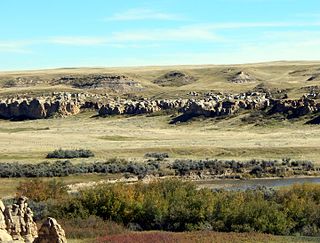
The Foremost Formation is a stratigraphic unit of Late Cretaceous (Campanian) age that underlies much of southern Alberta, Canada. It was named for outcrops in Chin Coulee near the town of Foremost and is known primarily for its dinosaur remains and other fossils.
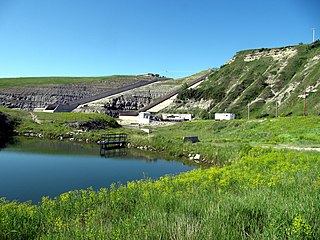
The St. Mary River Formation is a geologic formation of Late Cretaceous age of the Western Canada Sedimentary Basin in southwestern Alberta and northwesternmost Montana. It was first described from outcrops along the St. Mary River by George Mercer Dawson in 1883, and it takes its name from the river.
The Lea Park Formation is a stratigraphical unit of Late Cretaceous age in the Western Canadian Sedimentary Basin, Canada.
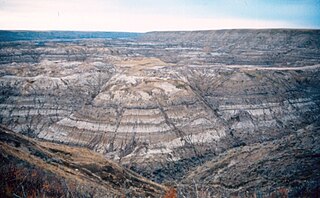
Within the earth science of geology, the Edmonton Group is a Late Cretaceous to early Paleocene stratigraphic unit of the Western Canada Sedimentary Basin in the central Alberta plains. It was first described as the Edmonton Formation by Joseph Burr Tyrrell in 1887 based on outcrops along the North Saskatchewan River in and near the city of Edmonton. E.J.W. Irish later elevated the formation to group status and it was subdivided into four separate formations. In ascending order, they are the Horseshoe Canyon, Whitemud, Battle and Scollard Formations. The Cretaceous-Paleogene boundary occurs within the Scollard Formation, based on dinosaurian and microfloral evidence, as well as the presence of the terminal Cretaceous iridium anomaly.

Coronosaurus is a genus of centrosaurine ceratopsian dinosaurs which lived in the Late Cretaceous, in the middle Campanian stage. Its remains, two bone beds, were discovered by Phillip J. Currie in the Oldman Formation of Alberta, Canada, and its type and only species, Coronosaurus brinkmani, was first described in 2005, as a new species within the genus Centrosaurus. Later studies questioned the presence of a direct relationship, and in 2012 it was named as a separate genus. Coronosaurus means "crowned lizard", coming from "corona", Latin for crown, and "sauros", Greek for lizard; this name refers to the unique, crown-like shape of the horns on the top of its frill.

Albertadromeus is an extinct genus of orodromine thescelosaurid dinosaur known from the upper part of the Late Cretaceous Oldman Formation of Alberta, Canada. It contains a single species, Albertadromeus syntarsus.

Probrachylophosaurus bergei is a species of large herbivorous brachylophosaurin hadrosaurid dinosaur known from the Late Cretaceous Campanian Judith River Formation, of Montana and the Foremost Formation of Alberta.
The Kootenay Group, originally called the Kootenay Formation, is a geologic unit of latest Jurassic to earliest Cretaceous age in the Western Canada Sedimentary Basin that is present in the southern and central Canadian Rockies and foothills. It includes economically important deposits of high-rank bituminous and semi-anthracite coal, as well as plant fossils and dinosaur trackways.














